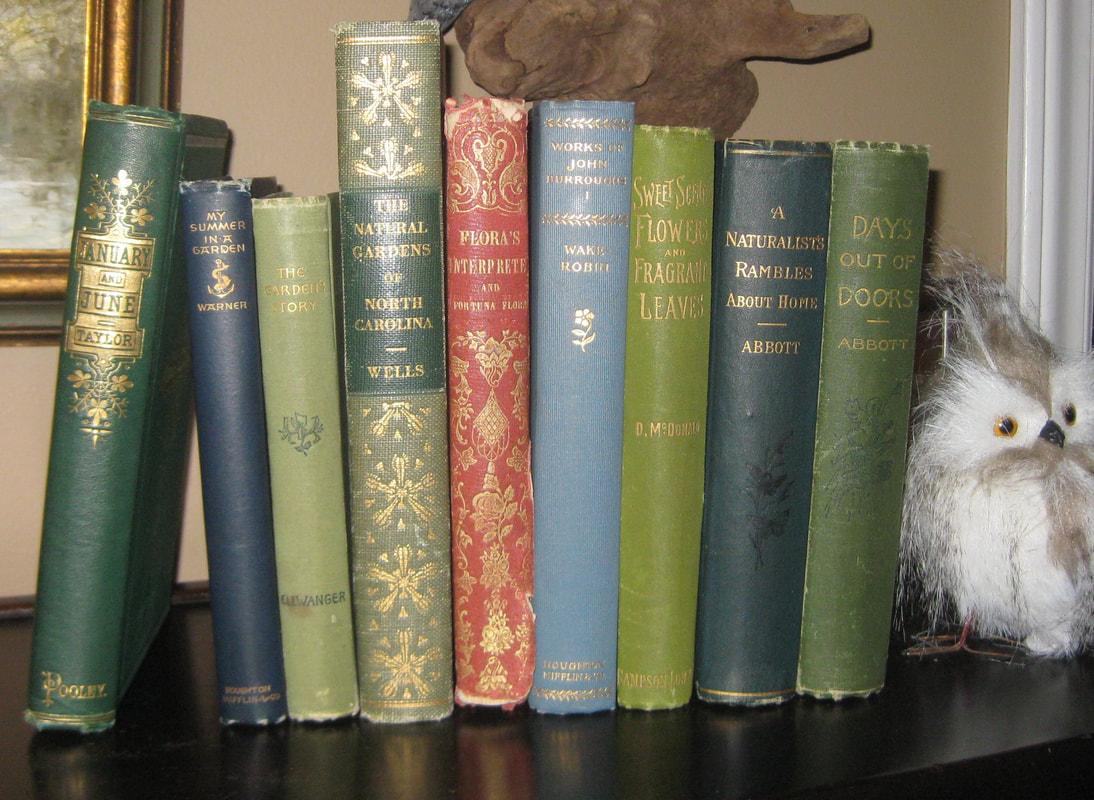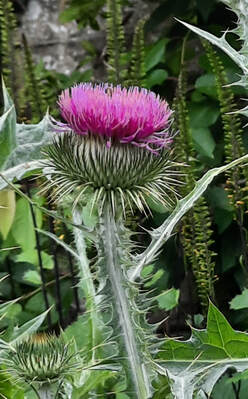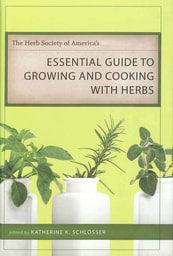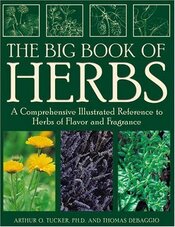Kathy's bookshelf....
FROM MY BOOKSHELF: Learning from gardeners of years gone by...
|
Mrs. William Starr Dana (Frances Theodora Parsons) wrote her 346 page guide to the Wild Flowers of America in 1893. The copy I have is the sixty-six thousandth edition printed in 1903 and illustrated by Marian Satterlee and Elsie Louise Shaw. She provides descriptions, names, haunts, and habits of nearly 500 plants.
Each plant includes her personal memories and experiences with the plants. This was obviously a sought-after book for many years and can still be found online. from page 64 - 65:
New Jersey Tea, Redroot Ceanothus americanus. Buckthorn Family Root—Dark red. Stem - shrubby; one to three feet high. Flowers—White, mall, clustered. Calyx—white; petal-like; five-lobed; incurved. Corolla—with five long-clawed hooded petals. Stamens—five. Pistil—one, with three stigmas. This shrubby plant is very common in dry woods. In July its white feathery flower-clusters brighten many a shady nook in an otherwise flowerless neighborhood. During the Revolution its leaves were used as a substitute for tea. |
Helen Rutherford Ely wrote Another Hardy Garden Book in 1905, but reading her is like you are walking at her side as she takes you through her garden. She shares all the information your might need to plant her favorites in your own garden.
Her writing skills are such that it is pleasant reading for the amount of information you are given: from page 195: "Everything accomplished in these Autumn months is so much gained for the following Spring. First of all, there are the seeds to be gathered--for why incur the expense of buying when those raised in your own garden may be just as fine and much fresher than those from the seed stores? Small cardboard or tin boxes, each with a pasted label with the name of the seed it contains, are the best in which to store the seeds. ...Among the seeds easiest to gather, and surest to grow the following spring are Asters, Balsams, Centaureas (cornflowers), Cosmos, Calendulas, Poppies of all kinds, Marigolds, Nasturtiums, Sunflowers, Zinnias, Hollyhocks, Sweet Williams, Foxgloves, and Larkspurs. Sweet peas should not be allowed to form seed pods or they will crease to bloom." |
Donald McDonald set out on a different path in his 1895 book. After asking where he could find a list of scented plants, and learning there were no books available, he determined to create one. Each of his 136 pages are filled 3 - 10 descriptions of scented plants. His knowledge of poetry equals his plant knowledge:
from page 33-33, describing Hawthorn or May Blossom (Crataegus oxycantha): "The scent of the May Blossom is proverbially sweet, and poets have much to say in its praise; poor Keats, who was passionately fond of the flower, addresses it thus:-- "So I straightaway went to pick a posy, of luxurious May both white and rosy, A bush of May bloom with bees about them. Ah, sure no tasteful nook could be without them." |
Ever wonder how Thistle came to be the
"emblem" flower of Scotland??....
|
The Legend of the Thistle: Little Warriors
That a nation should choose a weed, and that a prickly one, for its emblem, is to be wondered at by those who do not know the following story. Long ago the Danes were invading Scotland. It was a known fact that they never attacked at night, considering it unworthy of warriors. The Scots, knowing this, were sleeping peacefully one night when, unknown to them, the enemy changed their tactics and prepared an attack by moonlight. They landed beneath the cliff where the Scots were encamping and began their stealthy climb. One huge Danish warrior, impatient of the slowness of his followers, pushed ahead. Like an adder he slipped his great body through the undergrowth till within a few yards of where the Scottish sentry stood. Suddenly a cry of pain, mingled with a curse, broke the stillness of the night! Unknowingly the giant warrior had blundered into the very arms of the enemy—not the Scottish army, but the Scottish thistle! In the middle of the thistle bed he crouched, his brawny bare limbs stabbed and pierced by a million little swords, and there betrayed by his cry, he was discovered by the sentry. Crushed beneath his body the little warriors lay, crushed but triumphant, while the Scots completed the victory which the thistle’s tiny swords had begun. From Legends of the Flowers, by Janet Hepworth. c. 1920s by Blackie & Son Ltd., London and Glasgow |
Recommended Contemporary Books
The Encyclopedia of HerbsArthur O. Tucker and Thomas DeBaggio
This meticulously researched compendium provides every aspect of growing, identifying, harvesting, preserving, and using more than 500 species of herbs. Thorough profiles provide a plant's botanical name and family, whether it is an annual or perennial, its height, hardiness, light requirements, water consumption, required soil type, and pH. The often fascinating history of the plant, the chemistry of its essential oils, and its culinary, landscape, and craft uses are also included, as is advice on how to propagate. For the first edition of their work, both authors received The Gertrude B. Foster Award for Excellence in Herbal Literature from the Herb Society of America. This new edition adds important species and includes updated nomenclature. |
The Culinary Herbal Susan Belsinger and Arthur O. Tucker
Good cooks know that nothing beats fresh-clipped herbs. The gorgeously photographed Culinary Herbal, by herb experts Susan Belsinger and Arthur O. Tucker, highlights 97 delicious varieties—like black cumin, fenugreek, lemon balm, and sassafras—that you’ll want to grow, whether you’re a gardener who loves to cook and the cook who loves to garden. Learn which herbs offer the most flavor, how to grow them at home, and how to put them to use. Additional information includes step-by-step instructions for harvesting, preserving, and storing, along with techniques for making pastes, syrups, vinegars, and butters. . |
Essential Guide to Growing and Cooking with HerbsKatherine K. Schlosser
Provides detailed information for cultivating 63 herbs, along with recipes submitted by members of the Herb Society. The first section provides horticultural information for each of the sixty-three herbs found in the National Herb Garden's Culinary Garden.In the second part of the book, HSA members offer classic and creative recipes. The concluding section of the book contains a fascinating personal tour of the two-and-one-half-acre National Herb Garden, which lies in the heart of Washington, D.C., at the center of the United States National Arboretum. Schlosser received the Gertrude B. Foster Award for Excellence in Herbal Literature from the Herb Society of America for this work. |
Beyond Rosemary, Basil, and ThymeTheresa Mieseler
Beyond Rosemary, Basil, and Thyme is a unique book that encompasses seventy interesting and uncommon herbs. Several of the described plants are cat’s whiskers, cape mallow, caracalla, jasmine star, pepiche, porterweed, and scented geraniums. Each herb is outlined with history, a description, culture and growing, propagation and uses. You will find herbs easy to use in the kitchen, herbs to grow in the landscape, and many herbs to plant in containers for the deck or patio. It’s about fragrance and beautiful flowers! The book has many tasty recipes and how-to directions for herbal projects! To order, visit Shady Acres Herb Farm website. |
|
Additional books: some are a little older, some a lot older, some new, but every one of them is worth seeking out:
Herbs and The Earth. Henry Beston, David R. Godine, Publisher (Boston)--A special edition published for members of The Herb Society of America, Inc. Original publication 1935. This edition, 1990.
More than a gardening book, this is a singular example of a man thinking about what he grows, and into these conjectures weaving the fabric of the past. Here are the various herbs and their horticultural characteristics; but here, as well, are their antecedents, their ancient lore, and their curious habits.
Women and Their Gardens, A History from the Elizabethan Era to Today. Catherine Horwood, Ball Publishing, 2010.
Horwood brings to life the care with which Thomasin Tunstall sent her hellebores to John Parkinson for his new plot in the Coven Garden in the 1620s, and the passion of Lady Mary Coke in designing her garden at Notting Hill House in George IIIs reign. She salutes the determination of intrepid plant collectors from Lady Amherst who brought the glorious Clematis montana to England, to the Victorian widow who protected a euphorbia inside her hatbox on its journey home. From these triumphs to the battles fought against male-dominated institutions, from the horticultural pioneers to the bringers of change in society's attitudes, this book is a celebration of the best species--gardening women.
Secrets of Saffron: The Vagabond Life of the World's Most Seductive Spice. Pat Willard, Beacon Press, Boston, 2001.
Guided with wit and assurance by acclaimed food writer Pat Willard, we roam the rich landscapes of history and personal memory. We dine in the heavenly gardens of Persia; bathe with Alexander the Great; are served golden swans at the medieval court of France. With Willard's help we also discover the quiet comforts of saffron, from soups that have eased illness to pies that defy death, until we arrive at last in the present day at a small garden in Brooklyn. Told in sumptuous prose, complete with fabulous ancient and modern recipes.
Gardening Through the Ages, An Illustrated History of Plants and Their Influence on Garden Styles--from Ancient Egypt to the Present day. Penelope Hobhouse, Simon & Schuster, NY, 1992.
Against a background of scholarship, Penelope Hobhouse focuses on the plants themselves and the interest they have aroused. She explores the perennial interaction between what plants are available and the ideas of the people who grow them. She demonstrates that plants, however inspiring, remain the raw material of the garden maker's talent, and explores the extent to which gardeners are creatures of their age. Beautiful photos throughout the 328 pages make this readable academic tome a pleasure.
Southern Herb Growing. Madalene Hill and Gwen Barclay, Shearer Publishing, 1987.
A comprehensive guide to growing 130 herbs in the conditions peculiar to the American South including her Texas home. Hill gives details on what to plant, when to plant it, and how to take care of it in addition to pointers on propagating, cultivating and harvesting your herbs. She includes ideas for using the herbs and some of their history. She and her daughter Gwen also offer a variety of easy to follow recipes. Full color photos make this book extra special. Madalene was a long-time member of the Herb Society of America, Inc. and served as President.
Scent: A Natural History of Fragrance. Elise Vernon Pearlstine, Yale University Press, 2022.
In this wide-ranging and accessible new book, biologist-turned-perfumer Elise Pearlstine turns our human0centered perception of fragrance on its head and investigates plants' evolutionary reasons for creating aromatic molecules. Following themes of spirituality, wealth, power, addiction, royalty, fantasy, and more, she uncovers the natural history of scented substances and their intersection with human culture and civilization.
Herbs and The Earth. Henry Beston, David R. Godine, Publisher (Boston)--A special edition published for members of The Herb Society of America, Inc. Original publication 1935. This edition, 1990.
More than a gardening book, this is a singular example of a man thinking about what he grows, and into these conjectures weaving the fabric of the past. Here are the various herbs and their horticultural characteristics; but here, as well, are their antecedents, their ancient lore, and their curious habits.
Women and Their Gardens, A History from the Elizabethan Era to Today. Catherine Horwood, Ball Publishing, 2010.
Horwood brings to life the care with which Thomasin Tunstall sent her hellebores to John Parkinson for his new plot in the Coven Garden in the 1620s, and the passion of Lady Mary Coke in designing her garden at Notting Hill House in George IIIs reign. She salutes the determination of intrepid plant collectors from Lady Amherst who brought the glorious Clematis montana to England, to the Victorian widow who protected a euphorbia inside her hatbox on its journey home. From these triumphs to the battles fought against male-dominated institutions, from the horticultural pioneers to the bringers of change in society's attitudes, this book is a celebration of the best species--gardening women.
Secrets of Saffron: The Vagabond Life of the World's Most Seductive Spice. Pat Willard, Beacon Press, Boston, 2001.
Guided with wit and assurance by acclaimed food writer Pat Willard, we roam the rich landscapes of history and personal memory. We dine in the heavenly gardens of Persia; bathe with Alexander the Great; are served golden swans at the medieval court of France. With Willard's help we also discover the quiet comforts of saffron, from soups that have eased illness to pies that defy death, until we arrive at last in the present day at a small garden in Brooklyn. Told in sumptuous prose, complete with fabulous ancient and modern recipes.
Gardening Through the Ages, An Illustrated History of Plants and Their Influence on Garden Styles--from Ancient Egypt to the Present day. Penelope Hobhouse, Simon & Schuster, NY, 1992.
Against a background of scholarship, Penelope Hobhouse focuses on the plants themselves and the interest they have aroused. She explores the perennial interaction between what plants are available and the ideas of the people who grow them. She demonstrates that plants, however inspiring, remain the raw material of the garden maker's talent, and explores the extent to which gardeners are creatures of their age. Beautiful photos throughout the 328 pages make this readable academic tome a pleasure.
Southern Herb Growing. Madalene Hill and Gwen Barclay, Shearer Publishing, 1987.
A comprehensive guide to growing 130 herbs in the conditions peculiar to the American South including her Texas home. Hill gives details on what to plant, when to plant it, and how to take care of it in addition to pointers on propagating, cultivating and harvesting your herbs. She includes ideas for using the herbs and some of their history. She and her daughter Gwen also offer a variety of easy to follow recipes. Full color photos make this book extra special. Madalene was a long-time member of the Herb Society of America, Inc. and served as President.
Scent: A Natural History of Fragrance. Elise Vernon Pearlstine, Yale University Press, 2022.
In this wide-ranging and accessible new book, biologist-turned-perfumer Elise Pearlstine turns our human0centered perception of fragrance on its head and investigates plants' evolutionary reasons for creating aromatic molecules. Following themes of spirituality, wealth, power, addiction, royalty, fantasy, and more, she uncovers the natural history of scented substances and their intersection with human culture and civilization.













